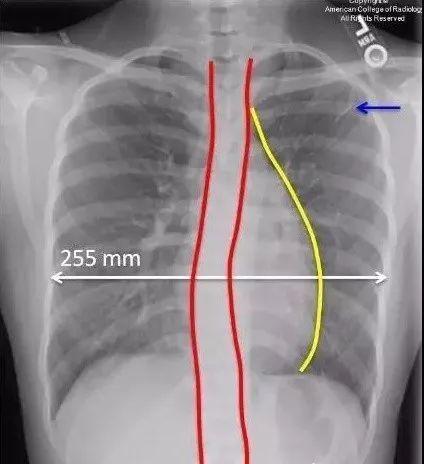The article originated from the Lilac Garden
What is straight back syndrome?
Straight back syndrome (SBS) refers to the disappearance of the normal physiological kyphosis of the thoracic spine, shortening the posterior diameter of the chest, reducing the effective volume of the chest cavity, and squeezing the contents of the mediastinum, resulting in a series of changes such as compression and displacement of the heart and large blood vessels.
#病史分享
A 21-year-old woman without any symptoms who had had a previous history of vacuole resection of video-assisted thoracoscopic sur-gery (VATS) before 17 months.

Figure 1. Orthostatic chest x-ray shows a cord shadow (blue arrow) visible in the upper field of the left lung; abnormal contour of the left mediastinal border (yellow arrow); mild scoliosis (red arrow); and a transverse diameter of about 255 mm in the T8 thoracic profile
Figure 2. Lateral positional x-ray does not show the lateral curved thoracic spine (red line); the T8 vertebral body level is the horizontal distance from the middle of the anterior margin to the posterior edge of the sternum, and the anterior diameter of the thoracic cage is about 77 mm (white arrow); no sternal deformity is seen.
Figure 3. Transverse CT is an image of the postoperative T8 vertebral body level before and after 17 months; T8 vertebral body compresses the left atrium (asterisk).
Figure 4. The left ventricle shifts to the left due to narrowing of the anteroposterior diameter of the thoracic cage (white arrow).
Figure 5. The curvature of the sagittal thoracic spine is straightened (yellow line); the sternum shows normal (orange line); and the heart, especially the left ventricle (asterisk), is deformed by compression due to narrowing of the anteroposterior diameter of the thoracic cage.
Figure 6. The yellow circle shows earlier ventricular contractions.
How does straight back syndrome occur?
SBS is an unexplained disorder of thoracic spine development, resulting in a straight thoracic spine, the disappearance of normal physiological kyphosis, and some patients even have mild depressions in the sternum and a slight herniation of the thoracic spine to the ventral side to form a flat chest or funnel chest, resulting in compression of the right ventricular outflow tract and aorta, causing cardiovascular morphological changes.
Clinical manifestations
It is more common in adolescents, most of which are asymptomatic and may be detected as a result of health check-ups or other medical conditions. Patients may present with chest tightness, tingling in the precordial region, and palpitations, which may be relieved after rest.
Physical examination: the thoracic cage is flat, the back spine is straight, and even slightly protruding to the ventral side, the physiological kyphosis disappears, due to the displacement of compression, the right ventricular outflow tract, pulmonary artery and aorta are close to the posterior edge of the sternum, thus producing the effect of enhanced blood flow ejection vibration, so the I.-III. sm can be heard in the pulmonary artery valve area, and the murmur is enhanced in the inhalation and recumbent position, P2 hyperliteration, easy to misdiagnose as congenital heart disease, such as pulmonary stenosis, atrial septal defect, ventricular septal defect, etc. ECG may have slight ST segment changes, complete or incomplete right bundle branch block.
peculiarity:
1. The normal physiological kyphosis of the thoracic spine disappears, shortening the posterior diameter of the chest, reducing the effective volume of the chest cavity, and squeezing the content of the mediastinum, resulting in a series of changes such as compression and displacement of the heart and large blood vessels.
2. Most patients do not have any symptoms, and some patients have chest pain, palpitations, mitral valve prolapse, etc.
3. The illusion of cardiac hypertrophy may result from a decrease in the distance between the sternum and the thoracic spine. If accompanied by other abnormalities of the heart (such as a murmur due to compression of the right ventricular outflow tract), it is easy to cause misdiagnosis.
X-ray check
X-ray presentation: conventional posterior anterior and left chest x-ray, which may show a loss of normal physiological kyphosis of the thoracic spine with considerable characteristics. It has been reported that the anterior and posterior diameter of the thoracic cage is shortened with the concave of the sternal handle and the sword process. Shortening of the anteroposterior diameter of the thoracic cage is the cause of compression and displacement of the large blood vessels of the heart, due to the forward and left movement of the heart, the heart forms a typical "pancake-like" change on the lateral position, while the lateral diameter of the heart is widened like the enlargement of the heart, the pulmonary artery segment is expanded, and the posterior sternum and posterior cardiac space are obviously narrowed or occluded.
Diagnostic criteria
1. Clinical and x-ray examination shows a straight back flat chest or funnel chest changes, and the smell of noise at the base of the heart is a necessary condition. And to exclude organic heart disease, such as pulmonary stenosis, atrial septal defects, ventricular septal defects, etc., and idiopathic pulmonary artery dilation;
2. Measured on the left side of the chest x-ray, T4 - T12 made a line, and the leading edge of the T8 vertebral body was measured with a vertical line, and its distance from the normal value was (1.93 ± 0.72) cm, if
3. Measure the thoracic anteroposterior diameter/cross diameter ratio ≤ 0.33.
【Copyright Notice】This platform is a public welfare learning platform, reprinted for the purpose of transmitting more learning information, and has indicated the author and source, such as teachers who do not want to be disseminated can contact us to delete